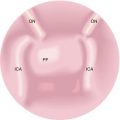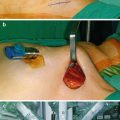John C. Watkinson and David M. Scott-Coombes (eds.)Tips and Tricks in Endocrine Surgery201410.1007/978-1-4471-2146-6_33
© Springer-Verlag London 2014
33. Surgery for Primary Hyperparathyroidism
(1)
Department of ENT/Head and Neck Surgery, Hull and East Yorkshire Hospitals NHS Trust, Castle Hill Hospital, Castle Street, Cottingham, East Riding of Yorkshire, HU16 5JQ, UK
(2)
Department of Head and Neck Surgery, School of Cancer Sciences, Institute of Head and Neck Studies and Education, University of Birmingham, Birmingham, UK
Abstract
Primary hyperparathyroidism (PHPT) is the third most common endocrine disorder affecting 0.3 % of the population and up to 1–3 % of postmenopausal women (Jessica et al. 2011).
PHPT is diagnosed by a raised serum (corrected) calcium associated with an inappropriately unsuppressed PTH level. It arises from oversecretion of PTH due to parathyroid gland(s) overactivity.
Primary HPT may be treated conservatively or surgically. Only approximately one-tenth of diagnosed patients end up undergoing parathyroidectomy.
Inherited forms of HPT: Germline mutations leading to loss of heterozygosity in tumor suppressor genes in multiple endocrine neoplasia (MEN)1 and CDC73, combined with a second mutation in somatic cells, can lead to parathyroid tumor development (Jessica et al. 2011).
Introduction
Primary hyperparathyroidism (PHPT) is the third most common endocrine disorder affecting 0.3 % of the population and up to 1–3 % of postmenopausal women (Jessica et al. 2011).
PHPT is diagnosed by a raised serum (corrected) calcium associated with an inappropriately unsuppressed PTH level. It arises from oversecretion of PTH due to parathyroid gland(s) overactivity.
Primary HPT may be treated conservatively or surgically. Only approximately one-tenth of diagnosed patients end up undergoing parathyroidectomy.
Inherited forms of HPT: Germline mutations leading to loss of heterozygosity in tumor suppressor genes in multiple endocrine neoplasia (MEN)1 and CDC73, combined with a second mutation in somatic cells, can lead to parathyroid tumor development (Jessica et al. 2011).
Presentation (See Also Chap. 31)
The pattern of presentation has altered radically due to the introduction of the serum autoanalyzer. Most PHPT is now discovered incidentally in primary care in minimally symptomatic patients. Traditionally, the presentation of hyperparathyroidism was labelled as “bones, stones, abdominal groans, and psychic moans.” These include bone pain, abdominal pain and cramps, renal stones, and depressed or altered mood.
In the preoperative work-up for all HPT patients, it is important to exclude medically treatable causes of multigland disease by assessing drug history (particularly lithium therapy) and checking for hypovitaminosis D. In addition, a family history of HPT should always be sought, as HPT due to multigland disease is far more likely to be an inherited condition.
Investigations
Investigations aim to confirm a biochemical diagnosis of PHPT and, in minimally symptomatic disease, to identify evidence of end organ damage so that surgery can be recommended.
All patients presenting with a likely diagnosis of PHPT require a serum calcium and intact PTH assay. In addition a serum vitamin D assay is required, and occasionally vitamin D levels must be replete before the diagnosis can be accurately made.
Although hypercalciuria is no longer an indication to advise parathyroidectomy, a 24 h urine collection for calcium and creatinine should still be obtained to exclude the diagnosis of familial hypercalcemic hypocalciuria (see Chap. 31).
Bone density assessment should be considered, particularly in conservatively managed patients to provide a baseline for regular monitoring. A renal ultrasound is performed to determine the presence of renal stones or nephrocalcinosis.
If the need for surgery is established, parathyroid imaging is normally performed (see Chap. 32).
Management
This should always be undertaken in a multidisciplinary setting, in close collaboration with an endocrinologist, preferably specializing in bone metabolism, and ideally with a radiologist specializing in head and neck imaging.
Stay updated, free articles. Join our Telegram channel

Full access? Get Clinical Tree






